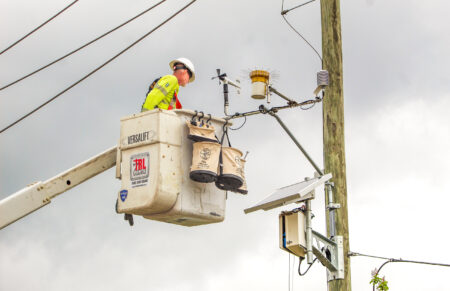CenterPoint Energy announced this week that it has begun installing 100 weather stations across the Houston region. The stations, which are being installed in phases, will provide measurements every 2 to 5 minutes and collect data such as rainfall, temperature, wind speed and humidity levels, according to CenterPoint. The data from these hyper-localized stations will be shared with state and local agencies and the general public.
A total of 100 weather stations are expected to be completed by June 1. Matt Lanza, a CenterPoint meteorology manager and member of its emergency preparedness and response team, said the data will allow the utility company to better predict weather events. "As a meteorologist, you want as much data as possible and as a utility, you need to have as much data as possible," Lanza said.

"So we're building up a history of data in certain parts of our area that is directly impacting our assets as well as the area itself." CenterPoint did not provide details regarding the projected cost of installing and maintaining the 100 weather stations. The utility company, which supplies electricity to much of the Houston area, has faced scrutiny for its preparedness and response after widespread, prolonged power outages during a derecho windstorm last May and Hurricane Beryl last July.
RELATED: CenterPoint made more than $1 billion in profits in 2024 amid Hurricane Beryl backlash While this will be the first weather station network of its kind in Houston, Lanza said utility companies in other parts of the country have had success with similar projects. "A lot of utilities that have done this out west have had a lot of positive results from this," he said. "You can use this data to input into weather models to help improve the model’s forecast, kind of at a shorter-term level, to understand things like the different pop-up thunderstorms that we have, especially in the summertime here.
" The installation of the weather station network is a part of CenterPoint's resiliency action plan , which was developed in response to the power outages that affected more than 2.2 million customers during Hurricane Beryl. The category 1 hurricane led to the death of at least 42 people in the Houston area, with several of the deaths being attributed to prolonged losses of electricity .
Given the weather stations’ intended function, Lanza said the stations are designed to withstand extreme weather conditions. Each station also has its own solar panel to provide self-sustaining power. "These are definitely going to be more durable than backyard weather stations," he said.
"They are designed to withstand just about anything you can throw at them. A situation like Hurricane Beryl last year, I feel pretty confident that they can withstand this." The data collected from the stations also will be shared with the National Oceanic and Atmospheric Administration, which includes the National Weather Service.
RELATED: National Weather Service in Houston cancels student intern program amid federal workforce cuts Tim Cady, a lead meteorologist for the National Weather Service’s Houston-Galveston office, said it hopes to put the new data sources to good use. "I think it's going to be incredibly useful, especially during active weather events," Cady said. "As we know, in Houston, we get a lot of flash flooding events, for example, and actually being able to see those rainfall totals add up in greater detail is going to be something that I think is going to really benefit our operations a lot.
...
if we're able to produce higher-quality warning and more targeted messaging as a result of these observations.".
Environment

CenterPoint begins rollout of 100 weather stations throughout Houston area

The utility company did not provide details regarding the projected cost of installing and maintaining the weather station network, which is being developed in response to the power outages that affected more than 2.2 million customers during Hurricane Beryl last summer.















